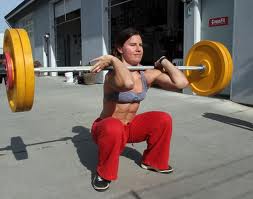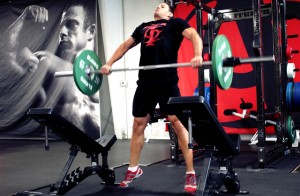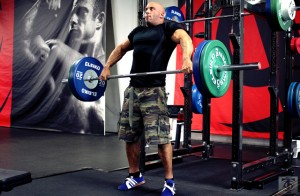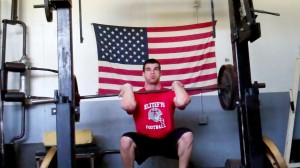I’ve gotten TONS of requests for tutorials, videos, or posts about the Olympic lifts. I’ve been a bit reluctant to do this in this past, only because they are SOO involved. Remember these are OLYMPIC EVENTS. People train their whole lives to master these moves – and I’m expected to teach it in 1 post…NO CHANCE. That’s like me teaching you basketball in one post – ain’t gonna happen.
That said, let’s dive into the CLEAN and see what we can do.
Let’s start by breaking the clean into phases.
Basically, a clean is a conventional deadlift from the floor into a jump shrug, then a high pull, then a catch, which is basically a front squat.

I like my athletes to have some mastery and comfort with each of those individual moves before attempting the clean. However, I know most high schools jump right into cleans, so I usually have to break bad habits and start over with my guys and girls.
If an athlete can’t properly perform the segments or phases of this lift, then there is no chance the complete lift will progress very far.
Here are some common mistakes:
- NOT deriving the power from the hips, glutes, hamstrings
- Reverse curling the bar
- Catching too high
- Not moving the bar fast enough
Conventional Deadlift
With any O-lift, starting from the floor requires a deadlift to get the bar moving. This is why I teach my athletes to pull with a conventional setup. Mastering the basic deadlift pattern is a must before one can perform a proper clean from the floor. This post is not about deadlifts, so let’s keep it short and sweet: Here’s a video of the deadlift…
[tube]http://www.youtube.com/watch?v=d0MALriNNEs[/tube]Jump/Power Shrug
This is a great way to learn to explode off the ground with the bar as well as keeping it tight to the body and elevating the scapula with your traps. This pattern helps reinforce pulling with the traps, not the hands and arms. The intent should be to explode off the ground, jump as high as you can and shrug explosively.
[tube]http://www.youtube.com/watch?v=AEG70IfhM8o[/tube]CT’s Power Hold
Christian Thibaudeau has been a huge influence in my lifting career. A former Canadian Olympic lifter, I can think of no better teacher for the O-lifts. Thibs uses what he calls “power holds” to teach athletes certain checkpoints along the full movement. He uses several, but for the purpose of this post, I like the “Extension” position power hold. That’s the man himself in the photo below holding the position: On your toes, calves and glutes flexed as they extend their respective joints and the shoulders are shrugged with the lats keeping the bar close and tight to the body. Per Thibs’s recommendation, perform about 5-7 reps of 4-10 second holds in the beginning of your training session. These are great moves to amp up your nervous system, increase time under tension (TUT), groove a movement pattern, and develop control and balance in this awkward position of the clean. That my friends in the definition of training efficiency!
Power High Pull
Possibly my favorite variation of all the O-lifts, the high pull forces a lifter to perform every aspect of the O-lift EXCEPT the catch! You still have to explode, triple extend, and pull high…another great way to reinforce pulling with the upper back rather than the hands and arms. You can also perform these with a Snatch grip, DBs, KB’s or even sandbags. Very versatile move with a huge amount of carryover and benefit. If performing this an alternative to the clean or snatch, keep sets/reps similar – more sets of less reps. 5-10 sets of 1-3 reps is my suggestion.
[tube]http://www.youtube.com/watch?v=AEG70IfhM8o[/tube]Front Squat
The “catch” position of the clean is the front squat. After the high pull, the lifter must drop under the bar, rotating the elbows forward and “catching” the bar in the front squat position. Like the conventional deadlift, I like my athletes to have some familiarity and comfort with this movement before expecting them to be able to dynamically catch a loaded barbell in the bottom position. Check out the photo below to see the bottom position of a front squat, as well as a great “catch” for a clean.
Full Clean (Putting it ALL together)
Hang Variations
There are numerous ways to alter the starting position of the O-lifts. You can pull from the floor, from blocks, or the hang position. The hang variation starts from a standing position. You can further divide this into below the knee, mid-thigh, or hip height. I simplify this and define the hang position as standing up and letting my arms hang down. Again, I’m not an Olympic lifting coach and I don’t need all those complexities. To start the lift from the hang, simply break at the hips, push them back and then explode up repeating the steps above. The only thing that change is the starting point. The lifter will have less time to generate momentum so this is a great way to build starting strength and train the rate of force development. The ability to generate force more quickly means more SPEED and POWER!
Mobility Issues
A Few Coaching Cues:
- Keep the bar close to your body
- Pull elbows HIGH (shoulder height)
- EXPLODE!!
- Don’t try to go too heavy – this is a speed lift!
- Triple Extension (ankles, knees, and hips)

Triple Extension at it’s finest. The ankles, knees, and hips are fully extended and the body is arched backward. Notice also, that the elbows are being pulled high.

